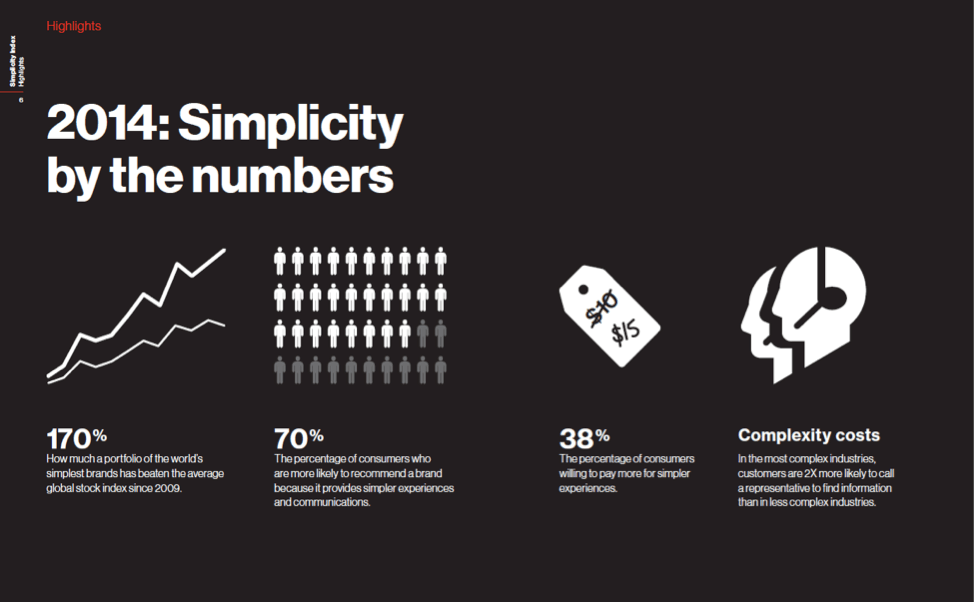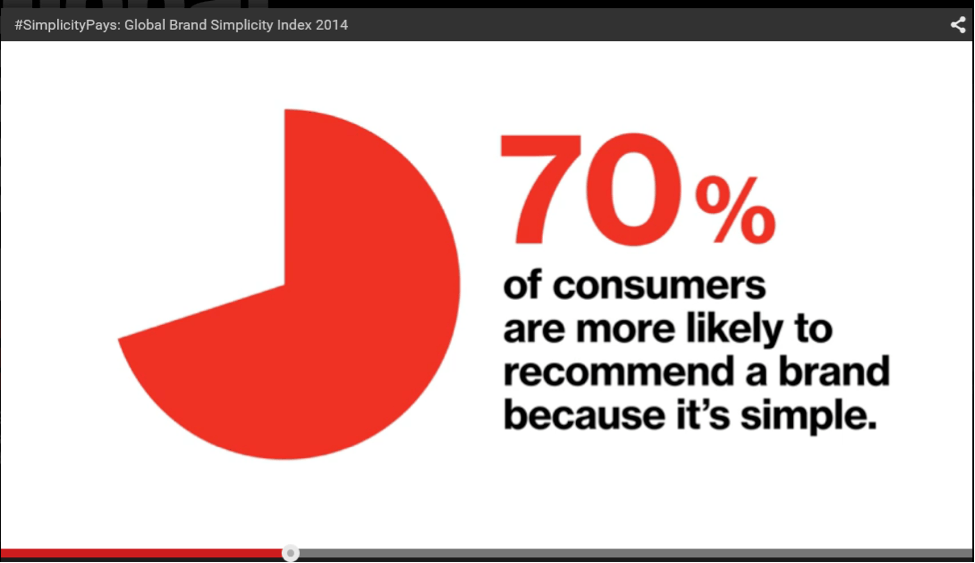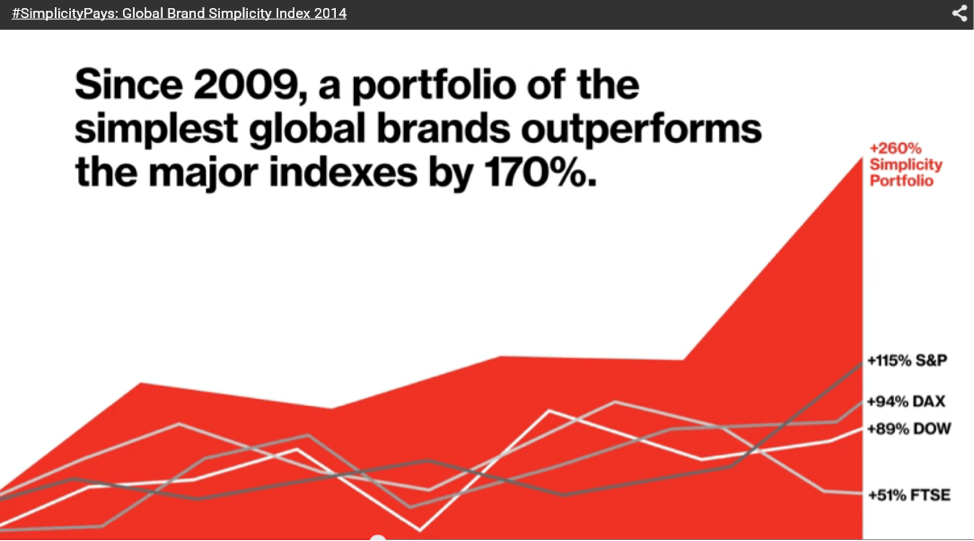
“…A condition of complete simplicity
(Costing not less than everything) …”
That’s a line from a T.S. Eliot poem, Little Gidding. It alludes to the fact that simplicity isn’t easy, and it isn’t cheap … but it’s priceless.
Simplicity, whether in a speech (“Four score and seven years ago…”), a tag line (“Just do it”), a product (the pet rock), an app (Dropbox), or a cheese sandwich, takes restraint and courage to produce, but will trump complexity most of the time – in marketing, in business operations, and in your daily life.
The Marketing Value of Simplicity
In both design and messaging (and when the design is the message), simplicity tells a powerful story. It says you know who you are and what you do, and you know who your customers are, and you know what is important to them.
It also illustrates your own confidence that you can deliver the goods, and inspires confidence in others.
Take, for example, search engine interfaces. Here are two screenshots of popular search engines, circa 2000 (thanks, Wayback Machine!):
Search Engine Watch maintains that Yahoo was “more relevant than competitors for many years, until the Google-era ushered in crawler-based results that were both comprehensive and highly relevant.”
But: the 2000 interface was noisy and crowded, offering so many choices that the eye isn’t certain where to look first. Using it felt like manipulating static.
In high contrast, Google met the market with the simplest possible interface. From the time it launched, I was hooked. The vast expanse of white space said to me: We know why you are here, you know why you’re here, here’s what to do next to get what you want. The fact that I preferred Google’s results was important too, but they had me at hello with their purist approach.
Other people, millions of them, came to prefer Google also. They may have read something different than I did into Google’s elegant simplicity, but whatever it was, it worked for them. That’s another great benefit of simplicity: it leaves room for your buyer, so they can add in their own layers of meaning. That makes it personal, which builds a relationship.
The Business Value of Simplicity
Branding agency Siegel+Gale (“Simple is smart” is their tagline) says that simplicity shortens the distance between the brand and the customer. In 2010 they began an annual Global Brand Simplicity Index to evaluate the “state, significance, and impact of simplicity on brands.” The report ranks more than 500 brands on how simple or complex their service, products, or touch points are perceived to be, by 12,000 consumers.
As Margaret Molloy, the agency’s Global Chief Marketing Officer, puts it in the 2014 Index report: “The results change, but the message is consistent – in a world crowded with complexity, simple experiences stand out. Simplicity brings clarity instead of confusion, and decision instead of doubt. And the rewards are real – greater customer loyalty, more innovation among employees, and increased revenue.”
The 2014 study (watch a summary) found that many people – 38% of them – will pay more for a less complicated experience. And customers are twice as likely to phone for help in more complex industries, raising the cost of service.
The disruptors – emerging companies that are resetting consumer expectations, such as Uber, Airbnb, Warby Parker and Nest – focus on four areas:
- Empowering consumers. These companies find new ways to shift control to buyers.
- Reimagining experience. The study points to Warby Parker’s way of making eyeglass-buying online feasible, by making it pleasant and even socially responsible.
- Removing friction. Find the pain points, then find a way to make them less painful. Or find a painless way around them, or remove them altogether.
- Saving time. We’re all busy, and we’re all grateful when something takes less time to deliver the same (or better) results than we were getting before.
Consumers were vocal about the faults of the companies at the bottom of the Simplicity Index:
- LinkedIn: “I can’t figure out why it’s really helpful,” comments one US respondent. Other concerns: security, too much email communication, and a difficult-to-navigate website.
- Three car rental companies, Avis, Budget, and Hertz made the bottom 10, with comments such as “There are always hidden things you need to look into,” “Advertising materials and the website are misleading.”
- Two banks made the list, CitiBank and HSBC, with this comment about the latter: “everything harder than it needs to be.”
And they were vocal about the virtues of the companies they appreciated for simplicity:
The bottom line is: The simpler customer experience is usually going to be the better customer experience. And the customer who has a better experience with you than with your competitor, or than with the status quo, is more likely to reward you with their business and their advocacy.
Simplicity is achieved by ruthless editing.
Simplicity is no accident. Strategy is what you say no to, and saying no is the hardest thing possible for many of us (companies and people alike). Knowing who you are is half the job; knowing who you are not is just as important. But it’s the basis of how you begin to simplify your brand, or your product, in order to deliver that less-complicated customer experience.
Nobody ever said it better than Steve Jobs:
To go back to the examples we began with: The Yahoo interface was noisy and complicated in 2000, and it still is. It’s distracting, and so it’s harder for the searcher to focus on what they came there for. Google’s deliberate unfussy design still makes it a much more pleasant user experience. I don’t know about you, but I feel smarter when I’m focused and undistracted, so the Google experience makes me feel better about myself. Again, the simplicity fosters a positive personal experience that makes it more likely that I’ll stick with Google.
#Simplicity Pays
From Sigel + Gale’s 2014 Global Simplicity Index, here are the 10 questions to ask your company leaders, to evaluate your own level of simplicity and consider what changes you might make:
- Is senior leadership committed to providing a simpler customer experience?
- Do I know what our brand’s purpose is, and is it articulated in a simple, memorable and inspiring way?
- Do we have the tools in place to get everyone to consistently deliver on our brand’s purpose?
- Is our brand focused on what drives preference within the market?
- Do customers share our view of who we are and what we want to be?
- Are our products and services clear and easy to navigate?
- Do we know the brand experiences where simplicity would be most appreciated by customers, and inspire greater brand loyalty?
- Do we have a simple road map for our customer journey?
- Are we actively seeking opportunities to remove points of friction in the customer experience, across all platforms?
- Do we regularly ensure that our customer experiences are both unexpectedly clear and remarkably fresh?
None of this is easy. As Jack Welsh said in an interview about reinventing GE:
Real leaders don’t need clutter. People must have the self-confidence to be clear, precise, to be sure that every person in their organization—highest to lowest—understands what the business is trying to achieve. But it’s not easy. You can’t believe how hard it is for people to be simple, how much they fear being simple. They worry that if they’re simple, people will think they’re simpleminded. In reality, of course, it’s just the reverse. Clear, tough-minded people are the most simple.
If you’re wondering what a paean to simplicity is doing in a blog post on a marketing automation site, it’s this:
Act-On began in 2008 by asking potential customers what they wanted most – and least – in a marketing platform. We listened, and then built a platform that said Yes to simplicity and No to bells and whistles. While we improve and expand the system every day (with weekly releases), we still focus on the basics. We also make it very easy for you to plug and play complementary technologies (such as CRM), but we’re not going to build those ourselves. There are excellent systems out there, and we’re intent on making it simple for you to integrate those, so you have control over the complexity of your own platform. We’re committed to bringing you simplicity – on your own terms – without compromise.
One last thought: in 2014 Forrester Research published The Forrester Wave™ Lead-To-Revenue  Management Platform Vendors” which evaluated the use of marketing automation by small marketing teams and large enterprises. (Act-On was a leader in both categories, I might note.)
Management Platform Vendors” which evaluated the use of marketing automation by small marketing teams and large enterprises. (Act-On was a leader in both categories, I might note.)
Forrester’s comments pointed to simplicity as a key factor: “L2RM platform buyers need to remember that more is not better; more is simply more. In fact, when you don’t need — or perhaps can’t use — extra functionality, more is sometimes worse. Small businesses — and small marketing teams in larger enterprises — need to carefully evaluate the L2RM platform Forrester Wave criteria to pick a solution that is right-sized for their needs.”
Download the full the full report here: Forrester Wave™ Lead-to-Revenue Management Platform Vendors.
More readings on simplicity:
How Steve Jobs’ Love of Simplicity Fueled A Design Revolution, The Smithsonian Magazine
What Is Strategy?, Michael Porter, The Harvard Business Review
Simplicity as Strategy, Ron Ashkenas, ChiefExecutive.net
Speed, Simplicity, Self-Confidence: An Interview with Jack Welch Noel Tichy and Ram Charan, The Harvard Business Review
The 2014 Global Brand Simplicity Index, Siegel+Gale
The Walden Woods Project (Our life is frittered away by detail… simplify, simplify. — Henry David Thoreau






